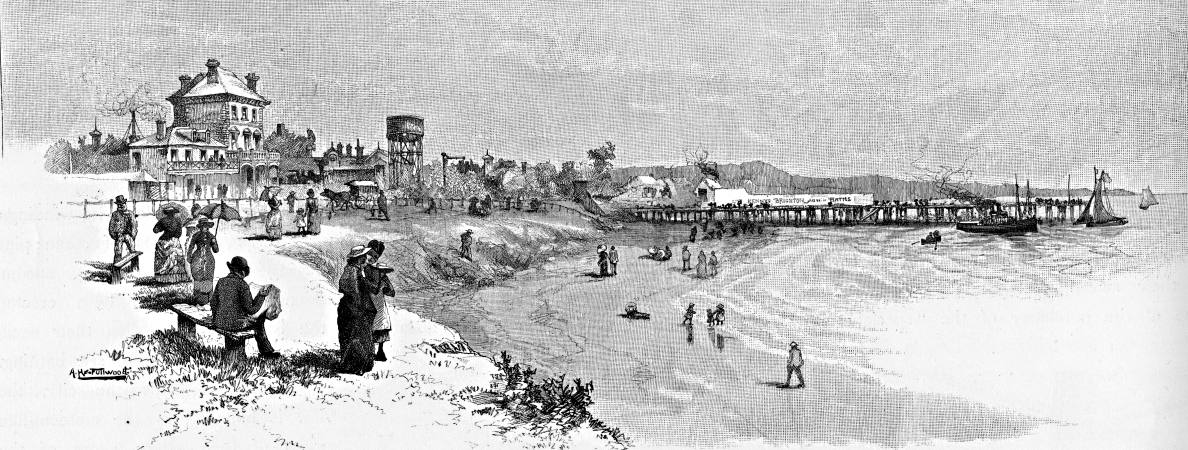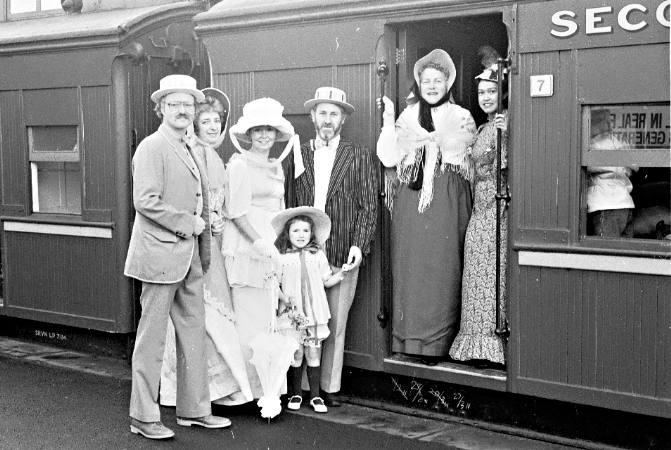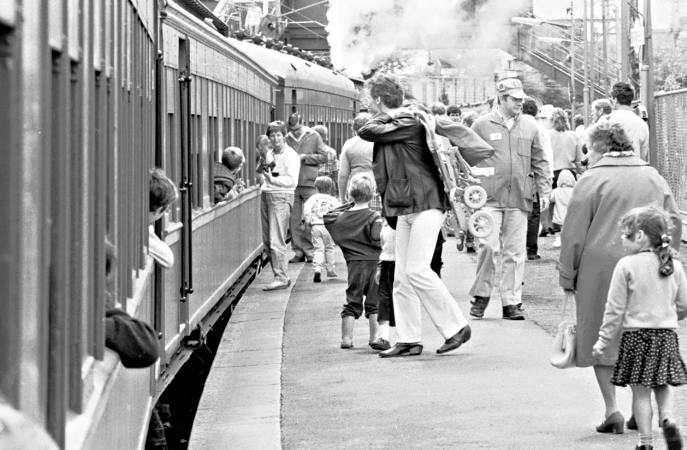The Brighton – Cheltenham Railway Line

Brighton Beach, 1888. Courtesy Kingston Collection.
In the 1850s a number of railway constructions were being considered to facilitate the movement of a growing population and new arrivals in the early settlement of Melbourne. It was on 20 January 1854 that the creation of the Melbourne and Hobson’s Bay Railway Company was approved with the first train journey from Melbourne to Sandridge occurring on 12 September in that year. This was the first steam operated rail service in Australia. [1] Other private companies were soon formed, linking growing towns in the colony. Legislative approval was given in 1857 to two companies to provide a service to Brighton. The St Kilda and Brighton Railway Company provided its service from Melbourne to Brighton via Windsor while the second company, Melbourne and Suburban Railway Company was less direct being via Richmond. Service to Bay Street (renamed North Brighton 1867) commenced in December 1859 and was extended to Brighton Beach two years later. The building of an extension to Picnic Point (Sandringham) was to take several more years but only after furious political debate and community agitation.
The construction of railways was an extremely costly affair and often private companies had difficulties raising the necessary finance. Recognizing the need for an appropriate transport system, and the frustration in achieving this through private enterprise, the government created the Victorian Railway Department in 1856. In 1878 the private lines to Brighton and Brighton Beach were sold to the Victorian Railways. Under this new authority a massive program of line construction occurred throughout Victoria. One example of this was the Melbourne to Mordialloc line which was opened in December 1881 by Thomas Bent, the then Minister of Railways.
Thomas Bent was appointed Minister of Railways in the government of Sir Bryan O’Loghlen in 1881 and was the one responsible for presenting to parliament the government’s plans for railway extensions. On 20 July 1882 the Legislative Assembly, sitting in committee, debated the government’s plans. Previous to this occasion the Assembly had agreed that priority would be given to country lines yet the first line noted in this new legislation was Brighton – Cheltenham. This caused a storm. Late in the debate Sir Bryan O’Loghlen agreed that ‘by some misadventure this line to Cheltenham was proposed.’ [2]
Sir John O’Shanassy, the member for Belfast, pointed out that the line would traverse a barren wilderness upon which a rabbit could not feed and queried why such a line should be made for the benefit of a small portion of a population when country districts were dying for want of railway communication. He went on to suggest people who visited Brighton to bathe walked to Picnic Point. It was absurd he suggested wanting to construct a railway. One politician challenged the proposal pointing out the distance between the Brighton and Cheltenham lines was not so great that a person could not travel to either station. Another claimed that a more deliberate waste of public money was never before attempted, while another suggested there were too many pleasure lines in the colony and that money should be applied to more necessary undertakings. The cry was that those lines provided for the benefit of pleasure seekers should be deferred until some future time. Any outlay upon a line from Brighton to Cheltenham could not be justified.
Defenders of the proposal, responding to the verbal assault by members of the Assembly, pointed out the extension to Picnic Point would be a boon for the summer crowds made up of the working classes of Melbourne, and costs would be recouped with the income the line generated. The traffic on Saturdays and Sundays to Picnic Point, it was claimed, would produce revenue in excess of interest on monies borrowed to finance the venture. Several other points were made during the debate including the comment that Brighton people who wanted to travel to Mordialloc or Frankston would not be obliged to take the longer route via Melbourne. Sir John O’Shanassy wondered who would want to travel to Mordialloc, casting doubt on their sanity. It was argued the construction of this line would facilitate the conveyance of dead bodies from Brighton and St Kilda to the proposed new cemetery at Frankston. Moreover, with suburbs such as Williamstown, St Kilda, Sandridge and Brighton becoming crowded, the line was seen by some as an inducement to people to erect villas at Picnic Point and beyond.
Longmore, the member for Ripon and Hampden, proposed that the extension of the Brighton line should stop at Picnic Point. When the time came to vote, this amendment was quickly accepted by the leader of the government and supported by a large majority of the House. O’Shanassy maintained his opposition to the proposal, along with twenty other colleagues. While the line, Picnic Point to Cheltenham, was aborted, the 2.69 miles from Brighton Beach to Picnic Point was authorized. [3]
The debate then centred on the route of the proposed extension. One Who Ought to Know writing to the Argus in 1882, while dismissing the idea that the Brighton line should meet with the Mordialloc line, suggested the extension should keep a quarter of a mile at the closest from the beach all along, so as not to interfere with the Esplanade. [4] A Lover of the Seaside warned that if the railway line was laid along the Esplanade the latter would be deserted, while A Believer in Railway Economy was concerned a big mistake would be made if the line proceeded east from the Esplanade rather than south easterly direction coming out near Richard’s (Ricketts) Point. [5]
In 1884, Duncan Gillies, the Minister of Railways, provided information, during the debate of the Railways Construction Bill, about several new suburban lines. One was the Brighton to Picnic Point extension. While it was acknowledged the precise route of the line would be influenced by the prices asked for private land, the survey had the line running from the Brighton terminal station and ending at the junction of Bay and Bluff roads, about one mile from the beach. However, for a short distance the line traversed the esplanade before branching off in a south-easterly direction through what at the time was private property. [6]
Once again voices were raised against the proposed route. The Argus reminded its readers that while parliament authorized a railway to the Point its members did not contemplate the destruction of the admired and popular promenade above the beach to accommodate the new line. Moreover, the Argus was surprised as to why a former Minister of Railways and local member, Thomas Bent, had not voiced objections given the strong feeling and wide opposition existing to it both within and beyond the district. [7] The local newspaper responded to the Argus statement saying there was no cause for alarm as three routes had been surveyed and a final decision had not been made. Once the decision was made the Brighton Southern Cross was sure their local member will give tongue when the final choice of route is made by the Commissioners and discussions commenced in the House of Assembly. [8]

Dressed up to join the 100th Anniversary Train. Courtesy Leader Collection.
The Argus suggested the railway department was advocating that the extension from Brighton Beach should cross South Road and enter the Moorabbin beach park and traverse it, running in a south easterly direction, before crossing the beach road to reach the terminus in the newly formed township of Picnic Point. However, the newspaper believed the railway engineers recognised the injustice of the proposed route because it crossed a road which every holiday was thronged with traffic, and would utterly destroy the only eligible seaside promenade to be found in the neighbourhood. [9] Moreover, the paper claimed, the hesitation of the railway officers about this route was reflected in the fact that two alternative routes were surveyed. The first alternative condemned by the Argus as a deviation of the scheduled line, runs for a short distance through a triangular reserve and then parallel with the beach road, at a short distance to the north of it, until it reaches the vicinity of the Retreat Hotel (later called the Hampton Hotel) where it curves northward, and passes on to Picnic Point. The second alternative was similar to the first except it runs a greater distance from the beach.
Once again correspondents to the Brighton Southern Cross voiced their opposition to the route, reiterating earlier arguments, but adding the idea that the key advocates for the new line were a few gentlemen, motivated by the desire to make large profits from subdividing and selling land they owned at Picnic Point and beyond. They saw the railway as a necessary inducement for people to reside there. As one writer claimed, Picnic Point was hardly anything more than a geographic expression. [10] David Abbott, a landowner at Picnic Point, and probably one of the ‘few gentlemen’ referred to in an earlier letter, responded to the numerous critical correspondents in the local newspaper. He agreed with the writers on the need to preserve the esplanade for the use of the public, but he was suspicious about their real intent. He believed they wanted to stop the railway altogether. This he suggested was because these writers were probably owners of property near existing railway stations who feared their land would depreciate in value as building lots were opened adjacent to the new line extension. [11]
In August 1885 Labertouch, on behalf of the railway commissioners, wrote to Thomas Bent sending him a tracing of the approximate route of the Picnic line. The Brighton Southern Cross reported, The proposed extension branches off from the main line at the nine mile post, near Were road, running almost parallel with the present line as far as the terminus, along the west frontage of the Triangular reserve, … to Holyrood street, where it deviates to the eastward, crossing Hastings street, near the intersection with Grenville street. At that point two possible routes to Eastbourne (Bay?) Road were under consideration but the upper one was considered best. [12]
Two years later the line to Picnic Point was officially opened. A special train was sent from Melbourne carrying politicians and gathering more travellers at various stops on the way. It was crowded by the time it reached the terminus at Picnic Point which was decorated with flags and greenery. The passengers joined local people and school children who had been given a holiday on this significant day. Thomas Bent as president of the shire was there, as was Matthew Davies as a minister of the crown. C H James a significant district land owner, was there together with his employee Cr Harold Sparks. All councillors from the City of Brighton and the Shire of Moorabbin were present. [13]

Boarding the Anniversary Train at Brighton Beach 1987.
Courtesy Leader Collection.
After the food came numerous speeches and replies. There were toasts to His Excellency the Governor who was not present on this occasion, Her Majesty’s Ministers in Victoria, the Legislative Council and Legislative Assembly, the Shire, the Railway Commissioners, the Clergy, the chairman Mr Bent, and the Contractors. Many of the speakers took the opportunity for self aggrandisement or to push a particular view or announce a new initiative. Mr Newman in proposing the toast to the ministers expressed his disappointment that the native youth of the colony were not devoting as much attention to politics as to horse racing, football and cricket. Later speakers disagreed pointing to native sons such as Bent, and Deakin as counter examples. John Keys, MLA and secretary of the shire, reminded his listeners that the new line and been constructed to give the people of Melbourne further facility for getting to the seaside, to get the dust blown off them. Charles Henry James looked forward to the time when railway profits would be sufficient to pay off Victoria’s debt. Cr Sparks saw the tram line that was under construction from the rail terminus as another milestone in the development of the Shire. Certainly the new train line extension from Brighton Beach to Picnic Point was well launched with words but the original idea for a line linking Picnic Point and Cheltenham was lost.

The 100th Anniversary Train 1987. Courtesy Leader Collection.
Footnotes
- Anderson, R., Stopping All Stations, 2010 page 13.
- The Argus 21 July 1882 page 9.
- The Argus ibid.
- The Argus 5 July 1882.
- The Argus 6 July 1882.
- The Argus 11 October 1884.
- The Argus 20 July 1885.
- Brighton Southern Cross 25 July 1885.
- Argus report republished in the Brighton Southern Cross 18 July 1885.
- The Argus 30 June 1885 & 13 July 1885.
- The Argus 3 August 1885.
- Brighton Southern Cross 29 August 1885.
- Brighton Southern Cross 3 September 1887.
